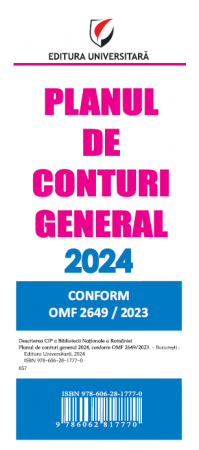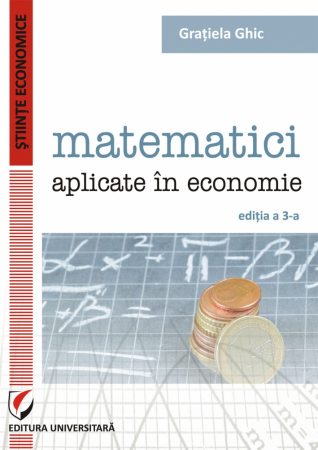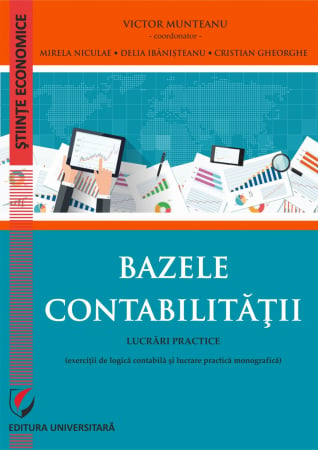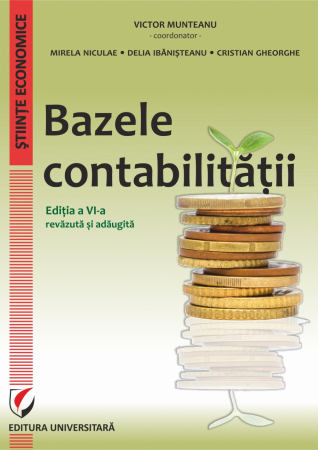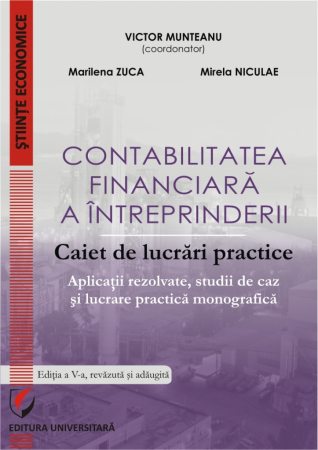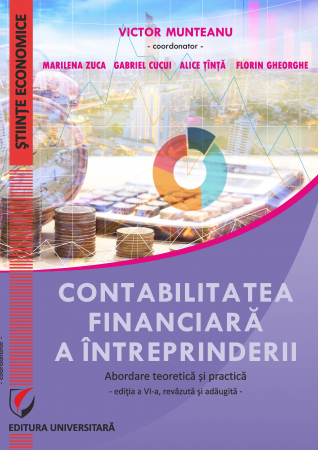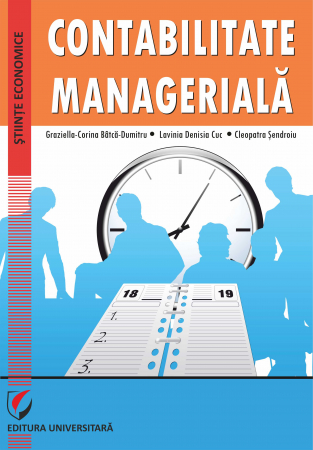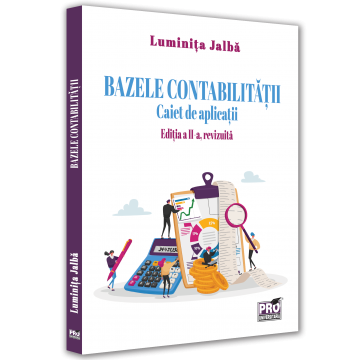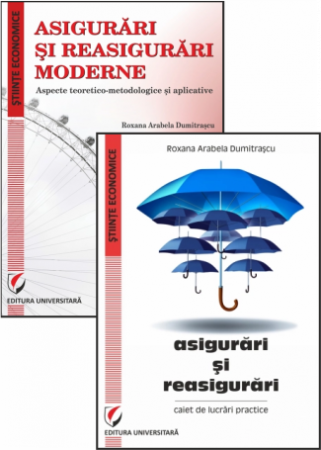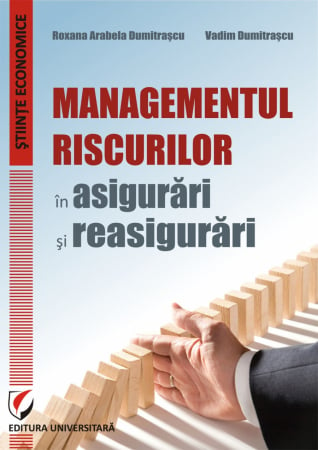ISBN: 978-606-591-576-3
DOI: 10.5682/9786065915763
Publisher year: 2012
Edition: I
Pages: 166
Publisher: Editura Universitară
Author: Maria-Cristina Stefan, Mihaela-Mirela Dogaru
- Description
- Download (1)
- Authors
- Content
- More details
- Reviews (0)
The book is addressed to those interested in studying economic phenomena and processes, to learn and deepen the basic concepts of economics. These objectives determined me to opt for a theoretical-applied work of political economy.
The structure of the paper includes topics presented synthetically, using graphs and mathematical calculation relations to facilitate the acquisition of notions and laws related to economic activity.
For most topics, applications are also presented, and for problems with a higher degree of difficulty, solutions have been made so that the reader can increase his level of training in the economic field.
The way of structuring the issue of economic theory and the use of an accessible language in presenting the concepts and phenomena make a substantial contribution to the knowledge of the theoretical-practical aspects of contemporary economics.
In the hope that I have largely met the proposed objectives, I would like to thank all those who have supported me - my family, my teachers and, last but not least, to invite readers to address my suggestions and proposals, which will contribute to improving this work.
The Author
-
Microeconomie - Teorie si aplicatii practice
Download
MIHAELA-MIRELA DOGARU
Assist. univ. PhD, Dimitrie Cantemir Christian University
MARIA-CRISTINA STEFAN
University lecturer PhD at the Faculty of Economics
Wallachian University of Targoviste
FOREWORD / 11
CHAPTER 1
INTRODUCTION TO ECONOMICS / 13
1.1. Theme synthesis / 13
1.1.1. Schools and currents of economic thinking / 13
1.1.2. Defining political economy / 14
1.1.3. The system of economic sciences / 15
1.1.4. The method of political economy / 17
1.1.5. Economic laws / 17
1.2. Control questions / 18
CHAPTER 2
BASIC ECONOMIC CONCEPTS / 20
2.1. Theme synthesis / 20
2.1.1. Economic activity - the form of human activity / 20
2.1.2. Human needs and economic resources / 22
2.2. Control questions / 25
2.3. Applications / 25
CHAPTER 3
MONEY AND THE ECONOMIC CIRCUIT / 27
3.1. Theme synthesis / 27
3.1.1. Nature, genesis and evolution of money / 27
3.1.2. The functions of money in the market economy / 28
3.1.3. Economic circuit / 29
3.2. Control questions / 31
3.3. Applications / 31
CHAPTER 4
ECONOMY AND ECONOMIC RATIONALITY. STRUCTURES OF THE ECONOMY / 36
4.1. Theme synthesis / 36
4.1.1. National economy / 36
4.1.2. Underground economy / 36
4.1.3. Natural economy. Exchange economy / 37
4.1.4. Economic agents and forms of business organization / 38
4.1.5. The role of property in the market economy / 40
4.1.6. Models and types of market economy / 40
4.2. Control questions / 42
CHAPTER 5
PRODUCTION FACTORS / 44
5.1. Theme synthesis / 44
5.1.1. Labor production factor / 44
5.1.2. Land production factor (nature) / 45
5.1.3. Capital production factor / 45
5.1.4. Production neofactors / 47
5.2. Control questions / 47
5.3. Applications / 48
CHAPTER 6
USE OF PRODUCTION FACTORS / 52
6.1. Theme synthesis / 52
6.1.1. Combining production factors / 52
6.1.2. Productivity of production factors / 52
6.2. Control questions / 55
6.3. Applications / 56
CHAPTER 7
MARKET AND COMPETITION / 59
7.1 Synthesis of the topic / 59
7.1.1 Market / 59
7.1.2. Competitor / 63
7.2. Control questions / 65
7.3. Applications / 66
CHAPTER 8
APPLICATION / 69
8.1. Theme synthesis / 69
Elasticity of demand / 70
8.2. Control questions / 72
8.3. Applications / 73
CHAPTER 9
OFFER / 77
9.1. Theme synthesis / 77
9.2. Control questions / 79
9.3. ApplicationsI / 81
CHAPTER 10
THE INTERACTION OF DEMAND WITH SUPPLY AND THE BALANCE OF THE MARKET / 82
10.1. Theme synthesis / 82
10.2. Control questions / 83
10.3. Applications / 84
CHAPTER 1
CONSUMER BEHAVIOR AND ITS RATIONAL OPTIONS / 86
11.1. Theme synthesis / 86
11.2. Control questions / 92
11.3. Applications / 93
CHAPTER 12
PRODUCTION COST / 100
12.1 Synthesis of the topic / 100
12.2. Control questions / 105
12.3. Applications / 106
CHAPTER 13
PRICE / 112
13.1. Synthesis of the topic / 112
13.1. 1. The price concept / 112
13.1.2. Price functions / 112
13.1.3. Pricing policies / 113
13.1.4. Price formation / 113
13.2. Control questions / 114
13.3. Applications
CHAPTER 14
PROFIT / 116
14.1. Theme synthesis / 116
14.1.1. Definition / 116
14.1.2. Profit functions / 117
14.1.3. Profit indicators / 117
14.1.4. Factors influencing the size of profit / 118
14.1.5. Maximizing profit / 118
14.1.6. The price - cost - profit ratio and the establishment of the profitability threshold at the company level / 121
14.2. Control questions / 122
CHAPTER 15
LABOR MARKET / 124
15.1. Theme synthesis / 124
15.1.1. The concept and features of the labor market / 124
15.1.2. Labor supply and demand / 125
15.2. Control questions / 126
CHAPTER 16
SALARY / 127
16.1 Synthesis of the topic / 27
16.1.1. Concept and forms / 127
16.1.2. Salary typology / 128
16.1.3. Salary / 128
16.1.4. Factors influencing the size and depth of the salary / 129
16.1.5. Procedures for changing the size of the salary / 129
16.2. Control questions / 129
16.3. Applications / 130
CHAPTER 17
MONETARY MARKET / 133
17.1. Theme synthesis / 133
17.1.1. Monetary mass. Monetary aggregates / 133
17.1.2. Banking system / 133
17.1.3. Money market content - money supply and demand / 135
17.1.4. Money market structure / 136
17.2. Control questions / 137
17.3. Applications / 137
CHAPTER 18
CREDIT AND INTEREST / 140
18.1. Credit / 140
18.1.1. Definition, functions / 140
18.1.2. Features / 140
18.1.3. Typology / 141
18.2. Interest / 142
18.2.1. Definition / 142
18.2.2. Sources of loan capital / 142
18.2.3. Concepts regarding the nature of interest / 142
18.2.4 Size of interest / 142
18.2.5 Interest calculation / 143
18.2.6 Methods of credit retention / 143
18.2.7. Factors influencing the level and dynamics of the interest rate / 144
18.2.8. Interest typology / 144
18.2.9. Interest components / 144
18.3. Control questions / 144
18.4. Applications / 145
CHAPTER 19
CAPITAL MARKET / 150
19.1 Synthesis of the topic / 150
19.1.1 Securities - capital market products / 150
19.1.2 The concept and structure of the capital market / 151
19.1.3 Capital demand and supply / 152
19.1.4 Stock exchanges / 153
19.2 Control questions / 155
19.3 Applications / 156
CHAPTER 20
ANNUITY / 158
20.1 Synthesis of the topic / 158
20.1.1 Definition / 158
20.1.2 The formation mechanism of annuity / 158
20.1.3 Type of annuity / 159
20.1.4 The price of land / 160
20.2. Control questions / 160
CHAPTER 21
MARKET FAILURE / 162
21.1 Synthesis of the topic / 162
21.1.1 Causes of market failures / 162
21.1.2 Typical market failure situations / 162
21.2 Control questions / 165
Bibliography / 166
In the current economic and social context, in which the wave of specific turbulences is manifested, with different intensities, in the entire world economy, there is a real industry of opinions about the course of the economy. It remains for history to record the validity of the decisions taken and the extent to which these decisions respect the warnings issued by economists, from the first bad signals, in the sense of avoiding attempts to solve problems by deepening them.
This paper aims to take a first step towards mastering the conceptual framework of microeconomics, including a structured approach to methodology, notions and laws related to economic activity, methods and specific forms of expression, following the understanding of fundamental economic mechanisms. Presentation of all these elements is made in the service of economists, students and practitioners, without being limited to their requirements.
In the economics of the paper are presented practical examples in which a detailed presentation of the ways of understanding and mastering the fundamental economic concepts is made, so as to respond to the accessibility requirements for the widest possible circles of readers. Through the stated examples, having explanations and the presentation of the interpretation of the results, it can be stated that the paper is part of the series of tools "to be used" at the microeconomic level by all those interested in this regard.
The publication of the paper represents a stage of the scientific approach, and the comments, analyzes and suggestions that are expected to be launched by those interested, will be the most eloquent indicator that will confirm the achievement of this end.
Prof. univ. Dr. Gheorghe Popescu
Dimitrie Cantemir Christian University

6359.png)
![Microeconomics - Theory and Practical Applications - Mihaela-Mirela Dogaru, Maria-Cristina Stefan [1] Microeconomics - Theory and Practical Applications - Mihaela-Mirela Dogaru, Maria-Cristina Stefan [1]](https://gomagcdn.ro/domains/editurauniversitara.ro/files/product/large/microeconomie-teorie-si-aplicatii-practice-1529-583205.jpg)
